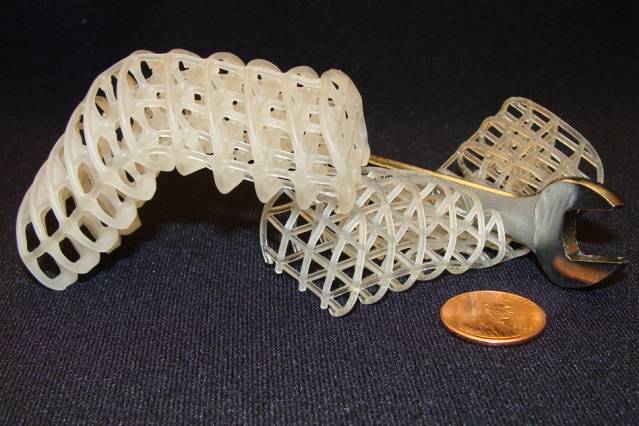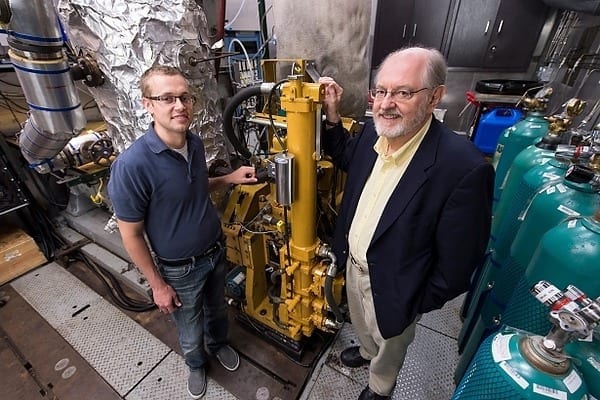Phase-changing material could allow even low-cost robots to switch between hard and soft states.
In the movie “Terminator 2,” the shape-shifting T-1000 robot morphs into a liquid state to squeeze through tight spaces or to repair itself when harmed.
Now a phase-changing material built from wax and foam, and capable of switching between hard and soft states, could allow even low-cost robots to perform the same feat.
The material — developed by Anette Hosoi, a professor of mechanical engineering and applied mathematics at MIT, and her former graduate student Nadia Cheng, alongside researchers at the Max Planck Institute for Dynamics and Self-Organization and Stony Brook University — could be used to build deformable surgical robots. The robots could move through the body to reach a particular point without damaging any of the organs or vessels along the way.
Robots built from the material, which is described in a new paper in the journalMacromolecular Materials and Engineering, could also be used in search-and-rescue operations to squeeze through rubble looking for survivors, Hosoi says.
Read more . . .
The Latest on: Squishy robots
[google_news title=”” keyword=”Squishy robots” num_posts=”10″ blurb_length=”0″ show_thumb=”left”]
via Google News
The Latest on: Squishy robots
- Toyota Is Making Fake Human Fingers to Improve Worker Safetyon April 27, 2024 at 2:23 pm
The fake fingers are made in Aichi Prefecture, Japan, at the company's headquarters in Toyota City. Toyota says they're made by a single employee, Takeo Mori, who's a manager in the Manufacturing ...
- Cornell University Utilizes Pigs, Mussels, and 3D Printing to Maintain Lake Source Cooling Systemon April 24, 2024 at 10:10 pm
Mark Tarazi ’24 crunched over the gravel at Ithaca’s East Shore Park marina with the new stack of 3D-printed shackle-alignment tabs.Out in Cayuga Lake, 250 feet down, there was an octagonal 4-ton scre ...
- 'Brilliant' £3 dust sponge that is 'best cleaning device' praised in 2,300 five-star ratingson April 24, 2024 at 5:21 am
Instead of ignoring the chore altogether, Amazon customers have been raving about a £3 tool that wipes away dust and debris in one clean swoop. Whilst you may have seen Scrub Daddy for its two-sided ...
- Tiny rubber spheres used to make a programmable fluidon April 23, 2024 at 11:25 am
Now, a team of researchers at Harvard University published a study where they used a simple hydraulic gripper with no sensors and no control systems at all. All they needed was silicon oil and lots of ...
- Ex-Rock Hill officer joins three others in Republican York County sheriff 2024 raceon April 16, 2024 at 9:16 am
Retired Rock Hill police Lt. Tony Breeden, 55, filed as a Republican for sheriff on Monday. He left the Rock Hill Police Department in 2022 after more than 27 years of service. Breeden is a Marine ...
- 4D Printed robot dances and crawls via temperature shiftson April 14, 2024 at 5:00 pm
The robot could autonomously crawl forwards, backwards, or in a circle depending on the exact geometry of its hinge and could even navigate rough or squishy terrains like sand and silicone rubber. The ...
- This N.J. high school is in the running for $100K science prizeon April 11, 2024 at 8:03 am
Princeton High School is among ten national finalists for the Samsung Solve for Tomorrow competition after students developed a robot to help languages on the brink of extinction.
- Helldivers 2's new mission type is the glorious Helm's Deep holdout defense that I've dreamed of for monthson April 9, 2024 at 4:03 pm
Helldivers 2 is, generally, a game about taking the fight to the enemy by destroying nests, factories, and launching ICBMs. On the rare occasion that Super Earth is put on defense, it hasn't always ...
via Bing News











